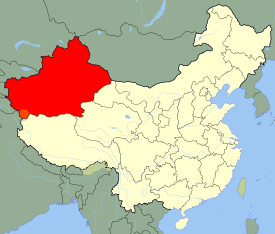Ürümqi
| Ürümqi ئۈرۈمچی 乌鲁木齐 |
|
|---|---|
| — Prefecture-level city — | |
| 乌鲁木齐市 | |
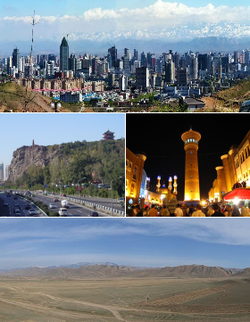 |
|
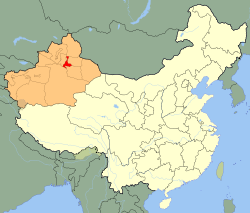 |
|
| Coordinates: | |
| Country | China |
| Province | Xinjiang |
| County-level divisions | 8 |
| Government | |
| - CPC Committee Secretary | Zhu Hailun[1] |
| - Mayor | Jerla Isamudin (吉尔拉·衣沙木丁 / جەرۇللاھ ھېسامىدىن) |
| Area | |
| - Total | 10,989 km2 (4,242.9 sq mi) |
| Population (2005) | |
| - Total | 2,681,834 |
| - Density | 244/km2 (632.1/sq mi) |
| Time zone | China Standard Time (UTC+8) |
| Postal code | 830000 |
| Area code(s) | 991 |
| License plate prefixes | 新A |
| GDP (2008) | CNY 102 billion |
| - per capita | CNY 43,211 |
| ISO 3166-2 | CN-65-01 |
| Website | http://www.urumqi.gov.cn/ (Chinese) |
| Ürümqi | |||||||||||
|---|---|---|---|---|---|---|---|---|---|---|---|
| Chinese name | |||||||||||
| Simplified Chinese | 乌鲁木齐 | ||||||||||
| Traditional Chinese | 烏魯木齊 | ||||||||||
| Literal meaning | beautiful pasture | ||||||||||
|
|||||||||||
| Uyghur name | |||||||||||
| Uyghur | Ereb Yéziqi: ئۈرۈمچی Latin Yéziqi: Ürümchi Yengi Yeziķ: Ürümqi Siril Yéziqi: Үрүмчи pronunciation in IPA: [yrymˈtʃi] |
||||||||||
Ürümqi or Ürümchi (![]() /uːˈruːmtʃi/; Uyghur: ئۈرۈمچی, ULY: Ürümchi; simplified Chinese: 乌鲁木齐; pinyin: Wūlǔmùqí), formerly Dihua (Chinese: 迪化; pinyin: Dǐhuà, Wade-Giles: Tihwa), is the capital of Xinjiang Uyghur Autonomous Region of the People's Republic of China, in the northwest of the country.
/uːˈruːmtʃi/; Uyghur: ئۈرۈمچی, ULY: Ürümchi; simplified Chinese: 乌鲁木齐; pinyin: Wūlǔmùqí), formerly Dihua (Chinese: 迪化; pinyin: Dǐhuà, Wade-Giles: Tihwa), is the capital of Xinjiang Uyghur Autonomous Region of the People's Republic of China, in the northwest of the country.
With an urban population of over 2.5 million people, Ürümqi, whose name means "beautiful pasture" in the Mongolian language of the Dzungar people,[2] is the largest city in China's western interior. Since the 1990s Ürümqi has developed economically and now serves as a regional transport node and commercial centre.
Contents |
History
Although Ürümqi is situated near the northern route of the Silk Road, it is a relatively young city. During the 22nd year of Emperor Taizong's reign in the Tang Dynasty, AD 648, the Tang government set up the town of Luntai in the ancient town seat of Urabo,[3] 10 kilometers from the southern suburb of present-day Ürümqi. Ancient Luntai Town was a seat of local government, and collected taxes from the caravans along the northern route of the Silk Road.
Little is heard of the region following the Tang Dynasty until the conquest of Dzungaria in 1755 under the Emperor Qianlong of the Qing Dynasty. The Dzungars were deliberately exterminated in a brutal campaign of ethnic genocide. One writer, Wei Yuan, described the resulting desolation in what is now northern Xinjiang as: "an empty plain for a thousand li, with no trace of man." After 1759 state farms were established, "especially in the vicinity of Urumchi, where there was fertile, well-watered land and few people."[4] It has been estimated that more than a million people were slaughtered, and it took generations for it to recover.[5]
During the Qing Dynasty (1763) the Qianlong Emperor named the expanded town of Luntai "Dihua" (Chinese:迪化; pinyin: Díhuà; Manchu: Wen de dahabure fu), meaning "to enlighten." In 1884, the Guangxu Emperor established Xinjiang as a Province, with Dihua as its capital.[6]
Following the founding of the People's Republic of China, on 1 February 1954, the city was renamed Ürümqi, meaning "beautiful pasture" in the Mongolian language of the Dzungar people.
The city was the site of major rioting in July 2009 due to conflicts between Han and Uyghur ethnic groups in which nearly 200 people were left dead; most of the victims were Han-Chinese. Reports of extensive police retaliation against the Uyghur minority have circulated ever since, despite the Chinese government having shut down access to emails and overseas phone calls.
Geography and climate
The largest city in the western half of the People's Republic of China, Ürümqi has earned a place in the Guinness Book of Records as the most remote city from any sea in the world. It is about 1,400 miles (2,500 km) from the nearest coastline as Ürümqi is the closest major city to the Eurasian Pole of inaccessibility, although Karamay and Altay, both in Xinjiang, are closer.[7] The city has an area of 10,989 km². The average elevation is 800 meters.
In Ürümqi a semi-arid climate (Köppen climate classification BSk) prevails. Ürümqi experiences very large differences between summer and winter, with hot summers, with an average July temperature high of 30.1 °C (86.2 °F), and cold winters, with an average January high of −7.4 °C (18.7 °F). The annual average temperature is 7.4 °C (45.3 °F). Ürümqi is semi-arid, with its summers slightly wetter than its winters. Its annual precipitation is about 290 millimetres (11.4 in).
| Climate data for Ürümqi | |||||||||||||
|---|---|---|---|---|---|---|---|---|---|---|---|---|---|
| Month | Jan | Feb | Mar | Apr | May | Jun | Jul | Aug | Sep | Oct | Nov | Dec | Year |
| Average high °C (°F) | −7.4 (18.7) |
−4.7 (23.5) |
2.7 (36.9) |
16.1 (61) |
23.1 (73.6) |
27.6 (81.7) |
30.1 (86.2) |
29.0 (84.2) |
23.1 (73.6) |
13.2 (55.8) |
2.0 (35.6) |
−4.4 (24.1) |
12.6 (54.7) |
| Average low °C (°F) | −16.6 (2.1) |
−13.7 (7.3) |
−5.4 (22.3) |
4.8 (40.6) |
11.2 (52.2) |
16.1 (61) |
18.2 (64.8) |
16.7 (62.1) |
11.2 (52.2) |
3.1 (37.6) |
−5.9 (21.4) |
−12.9 (8.8) |
2.2 (36) |
| Precipitation mm (inches) | 10.4 (0.409) |
10.0 (0.394) |
18.5 (0.728) |
32.3 (1.272) |
38.9 (1.531) |
36.2 (1.425) |
30.4 (1.197) |
23.3 (0.917) |
26.2 (1.031) |
26.3 (1.035) |
19.1 (0.752) |
14.6 (0.575) |
286.3 (11.272) |
| % Humidity | 78 | 77 | 71 | 48 | 43 | 43 | 43 | 41 | 44 | 58 | 74 | 78 | 58.2 |
| Avg. precipitation days (≥ 0.1 mm) | 9.2 | 7.2 | 7.2 | 6.8 | 6.8 | 8.0 | 8.4 | 6.3 | 5.0 | 5.5 | 6.9 | 9.6 | 86.9 |
| Sunshine hours | 101.6 | 128.8 | 180.5 | 248.0 | 283.3 | 282.7 | 298.7 | 301.0 | 262.6 | 224.4 | 127.4 | 84.3 | 2,523.3 |
| Source: China Meteorological Administration | |||||||||||||
Administrative divisions
Ürümqi currently comprises 8 administrative sub-divisions, county-level units, of these, 7 are districts and 1 is a county.
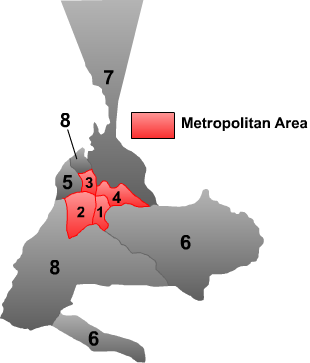 |
||||||||
| # | Name | Hanzi | Hanyu Pinyin | Uyghur (kona yezik̡) |
Uyghur Latin (yengi yezik̡) |
Population (2003 est.) | Area (km²) | Density (/km²) |
|---|---|---|---|---|---|---|---|---|
| 1 | Tianshan District | 天山区 | Tiānshān Qū | تىيانشان رايونى | Tiyanshan Rayoni | 490,000 | 171 | 2,865 |
| 2 | Saybagh District | 沙依巴克区 | Shāyībākè Qū | سايباغ رايونى | Saybagh Rayoni | 450,000 | 422 | 1,066 |
| 3 | Xinshi District | 新市区 | Xīnshì Qū | يېڭىشەھەر رايونى | Yéngisheher Rayoni | 390,000 | 143 | 2,727 |
| 4 | Shuimogou District | 水磨沟区 | Shuǐmògōu Qū | شۇيموگۇ رايونى | Shuymogu Rayoni | 180,000 | 92 | 1,957 |
| 5 | Toutunhe District | 头屯河区 | Tóutúnhé Qū | تۇدۇڭخابا رايونى | Tudungxaba Rayoni | 120,000 | 276 | 435 |
| 6 | Dabancheng District | 达坂城区 | Dábǎnchéng Qū | د اۋانچىڭ رايونى | 40,000 | 5,188 | 8 | |
| 7 | Midong District | 米东区 | Mǐdōng Qū | 290,000 | 3,594 | 56 | ||
| 8 | Ürümqi County | 乌鲁木齐县 | Wūlǔmùqí Xiàn | ئۈرۈمچى ناھىيىسى | Ürümchi Nahiyisi | 80,000 | 4,332 | 18 |
Demographics
According to the 2000 census, Ürümqi has 2,081,834 inhabitants, with a population density of 174.53 inhabitants/km².[8]
| Ethnicity | Population | Percentage |
|---|---|---|
| Han | 1.567.562 | 75.3% |
| Uyghur | 266.342 | 12.79% |
| Hui | 167.148 | 8.03% |
| Kazakhs | 48.772 | 2.34% |
| Manchu | 7.682 | 0.37% |
| Mongol | 7.252 | 0.35% |
| Xibe | 3.674 | 0.18% |
| Russian | 2.603 | 0.13% |
| Tujia | 1.613 | 0.08% |
| Kyrgyz | 1.436 | 0.07% |
| Uzbek | 1.406 | 0.07% |
| Zhuang | 878 | 0.04% |
| Tatar | 767 | 0.04% |
| Tibetan | 665 | 0.03% |
| Dongxiang | 621 | 0.03% |
| Miao | 620 | 0.03% |
| Korean | 588 | 0.03% |
| Other | 2.205 | 0.09% |
Economy
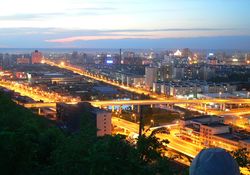
Ürümqi is a major industrial center within Xinjiang. Ürümqi, together with Karamay and Korla, account for 64.5% of the total industrial output of Xinjiang. Ürümqi is also the largest consumer center in the region, recording ¥41.9 billion retail sales of consumer goods in 2008, an increase of 26% from 2007. The GDP per capita reached US$6,222 in 2008.[9] According to statistics, Urumqi ranked 7th in 2008 by the disposable income for urban residents among cities in Western China.[10] Ürümqi has been a central developmental target for the China Western Development project that the Central Government is pursuing.
The Urumqi Foreign Economic Relations and Trade Fair (Chinese: 乌洽会) has been held annually since 1991. Its purpose is to promote domestic and foreign markets. The 17th Fair has attracted participants from the Ministry of Commerce and the China Council for Promotion of International Trade.[11]
As the economic center, Urumqi has expanded its urban area since the 1990s. The CBDs in the city increased rapidly all around the major districts. China CITIC Bank Mansion (中信银行大厦), located in one of the CBDs in North Xinhua Road, is the tallest building in Urumqi and Xinjiang; with a height of 229 metres, it is also the tallest in Northwestern China and Central Asia. Lacking a subway, the city built an outer ring road (外环路) in 2003, which considerably facilitates transport. Zhongshan Road (Sun Yat-sen Road, Chinese: 中山路) in Urumqi has been one of the ten most famous commercial streets in the People's Republic of China since 2005 (through official appraisals). The others are Wangfujing, etc. The commercial street of Zhongshan Road has the largest computer, mobile phone and consumer electronics market, i.e Baihuacun, Ccyber Digital Plaza and Fountain Plaza, in the Xinjiang Uyghur Autonomous Region; it is believed to be the focal point of technological products in Urumqi.
Tourism
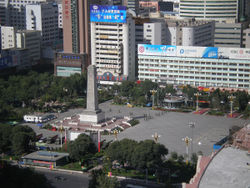
- The International Grand Bazaar Xinjiang (Chinese: 新疆国际大巴扎, Uyghur: شىنجاڭ خەلقئارا چوڭ بازىرى) is an Islamic bazaar located on South Jiefang Road (解放南路). It is one of the most attractive tour sites in Xinjiang and Urumqi.
- Hong Shan Mountain (红山) is the symbolic scenic spot of Urumqi, located in the Hong Shan Park.
- Glacier No. 1 (一号冰川), origin of Urumqi River, is the largest glacier located near a city in China.
- People's Square (人民广场)
- Nanhu Square (南湖广场)
- Xinjiang Uygur Autonomous Region Museum (新疆维吾尔自治区博物馆)
- Shuimugou Hot Springs (水磨沟温泉) is located 5 km northeast of Urumqi.
- Xinjiang Silk Road Museum (新疆丝绸之路博物馆) [1] is located right next to the Grand Bazaar at No.160 Shengli Road. Bus No.110 stops very close to it. It is located on the fourth and fifth floor of a very large European style building which houses a shopping complex as well. The admission charge is 30 Yuan per person. Most of the exhibits have English names as well and some of their guides speak some English.
- Ürümqi City Museum (乌鲁木齐博物馆) is located at South Nanhu Road 123 (南湖南路 123).
Education
Urumqi has many educational campuses including Xinjiang University, Xinjiang Normal University, Xinjiang Agricultural University , Xinjiang Medical University and many others.
Universities
- Xinjiang University (新疆大学)
- Xinjiang Medical University (新疆医科大学)
- Xinjiang Normal University (新疆师范大学)
- Xinjiang Agricultural University (新疆农业大学)
- Xinjiang Arts Institute (新疆艺术学院)
- Xinjiang University of Finance & Economics (新疆财经大学)
High schools
- Urumqi No.1 High School (乌鲁木齐市第一中学)
- Urumqi No.8 Middle School (乌鲁木齐市第八中学)
- Xinjiang Experimental High School (新疆实验中学)
- Xinjiang Production and Construction Corps No.2 High School (新疆生产建设兵团第二中学)
- Senior High School of Urumqi (乌鲁木齐市高级中学)
- Bayi Middle School of Urumqi (乌鲁木齐市八一中学)
Transportation
Air
Ürümqi is served by the Ürümqi Diwopu International Airport. The airport is one of the five major airports in the People's Republic of China. It is also a hub for China Southern Airlines. It has been rumored that a new airline China Central Airlines will start operations at the airport sometime in late 2010.
Rail
Urumqi is a rail hub of Xinjiang. It is the terminus of main line Lanxin railway. It is also the origin of the northern branch of the railway, which connects Alataw Shankou and Kazakhstan. There is also a high-speed rail line under construction, which will connect Urumqi with other major Chinese cities due for operation in 2014.
Road
- China National Highway 216
- China National Highway 312
- China National Highway 314.
Media

The Xinjiang Networking Transmission Limited operates the Urumqi People's Broadcasting Station and the Xinjiang People's Broadcasting Station, broadcasting in the Mandarin, Uyghur, Kazakh, Mongolian, Russian and the Kyrgyz languages.
The Xinjiang Television Station (XJTV), located in Urumqi, is the major TV broadcasting station in the Xinjiang Uyghur Autonomous Region. The local television station for Urumqi city is Urumqi Television Station (UTV)(乌鲁木齐电视台).
Sport
- Xinjiang Flying Tigers is a major basketball team in the region.
- Xinjiang Ticai is a local football team in the Chinese Football Association Yi League
International relations
Twin towns — Sister cities
Ürümqi is twinned with:
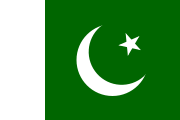 Peshawar, Pakistan
Peshawar, Pakistan Bishkek, Kyrgyzstan
Bishkek, Kyrgyzstan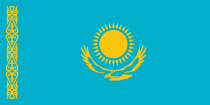 Almaty, Kazakhstan
Almaty, Kazakhstan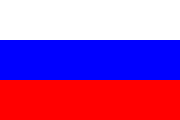 Chelyabinsk, Russia
Chelyabinsk, Russia
References and footnotes
- ↑ "Urumqi party chief, Xinjiang police chief sacked". Xinhua. 5 September 2009. http://news.xinhuanet.com/english/2009-09/05/content_12001223.htm. Retrieved 5 September 2009.
- ↑ "http://www.travelchinaguide.com/attraction/xinjiang/urumqi/valley.htm". Travelchinaguide.com. http://www.travelchinaguide.com/attraction/xinjiang/urumqi/valley.htm. Retrieved 19 February 2010.
- ↑ "Urumqi". Chinatoday.com.cn. 1 February 1954. http://www.chinatoday.com.cn/English/chinatours/urumqi.htm. Retrieved 19 February 2010.
- ↑ Millward (2007), pp. 95, 104
- ↑ Tyler (2003), p. 55
- ↑ "Online Encyclopædia Britannica". Britannica.com. 31 January 2007. http://www.britannica.com/EBchecked/topic/620188/Urumqi/278262/History. Retrieved 19 February 2010.
- ↑ Google Maps
- ↑ 2000年人口普查中国民族人口资料,民族出版社,2003/9 (ISBN 7-105-05425-5)
- ↑ "hktdc.com – Profiles of China Provinces, Cities and Industrial Parks". Tdctrade.com. http://www.tdctrade.com/mktprof/china/xinjiang.htm. Retrieved 19 February 2010.
- ↑ "乌鲁木齐人均可支配收入增长居西部十省第8位". http://www.nxein.com/zhjj/mzqyjj/200711/5573.html.
- ↑ 17th Urumqi Trade Fair opens "17th Urumqi Trade Fair opens — CCTV International". CCTV.com. http://www.cctv.com/program/bizchina/20080902/102963.shtml 17th Urumqi Trade Fair opens.
External links
- Ürümqi Government Official website
- Ürümqi travel guide from Wikitravel
- Images and travel impressions along the Silk Road – Urumqi
|
|||||||||||||||
|
||||||||||||||||||||||
|
|||||
|
|||||||
|
|||||
